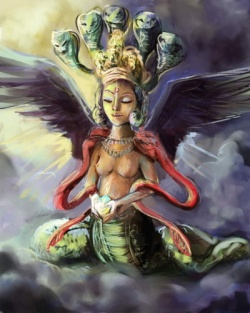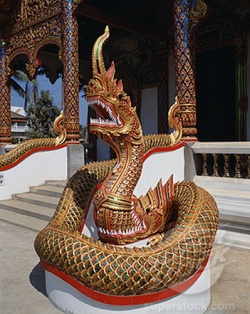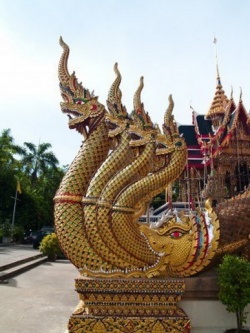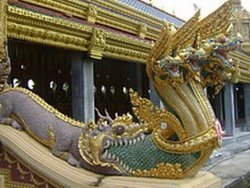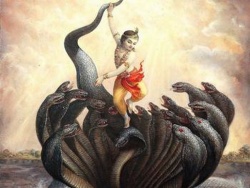Goddess Religion-Serpent
From the Book entitled: "The Cosmic Serpent" (DNA and the Origins of Knowledge ) by Jeremy Narby we learn the following:
" Since the very Beginning OF TIME..ON EVERY CONTINENT of the Earth where humanity has worshiped DIVINITY THE SERPENT/DRAGON/NAGA has been Recognized and ACCEPTED AS GOD.
According to the great educator Eugene Adams, from his film entitled: "Africans In Asia" we learn the following:
"There was a tribe in Asia called the NAGAS or the Divine people symbolized throughout Asia by the symbol of the the serpent or the dragon".
"That is their symbol. The NAGA means serpent or dragon-the snake. The NAGA was the symbol of the Asiatic black man. The tribe called the NAGAS-the Divine people.
From the Nile Valley to the Indus Valley on tombstones a symbol of immortality because of the serpents ability to change his skin is a sign of never dying, and is used throughout the planet earth". He said.
He continues: North and South America, Egypt, Asia, Africa and throughout the world its symbol of life after death.
The NAGA-The Serpent.In all ancient cultures. In all ancient religions the serpent is the symbol.
The NAGA-the symbol of divinity-God!
The original inhabitants of Southeast Asia were called the Mons who were an AFRICAN tribe.
The serpents of the Nagas represent cosmic forces". He said.
And according to other sources:
Nagarjuna of India, for example is shown with an aura or halo of Seven Serpents, which is an indication of a very high degree of Initiation.
The symbolism of the Seven Serpents, usually Cobras, are also on the Masonic aprons. In the Buddhistic ruins of Cambodia (Angkor) and Ceylon.
The great temple-builders of the famous Angkor Wat ("The God Horus Lives"), were considered to be the semi-divine Khmers.
They , included in the Temples is lined with the seven headed , Nara. The avenue leading to the temple is lined with Seven-headed Naga.
And even in Mexico, there are the Naga which are known as the Isquo. Nagal.. In China, the Naga is given the form of the Dragon and has a direct association with the Emperor and is known as "Son of Heaven".
The first Dynasty- the "Chang Dynasty", were Black people from the Sudan and Egypt.
The Chinese are even said to have originated with the Serpent demi-god and even to speak their language Naga-Krita.
For a pace that has no serpents Tibet, they are still known in symbolic sense and are called; "Lu" (Naga). Nariland called in Tibetan, Lu-trul.
While in Egypt the same association is termed "King Initate". He said.
He continues: In the Western traditions we find the same ubiquity, for the Naga, or Serpent. In Genesis, the Serpent is a Naga who instructs the new infant (humanity) in what is called the Knowledge of Good and Evil.
The Christian churches has unfortunately transformed the Iniate-Teacher into a tempting and negative demon character.
Naga is one of a handful of rare words surviving the loss of the first universal languages (Naacal).
In Buddhism, Wisdom has always been tied symbolically to the figure of the Serpent.
GODDESS RELIGION-SERPENT
According to E.A Budge we learn the following:
"In the ancient practice of the Goddess worship:
The Serpent was the symbol, perhaps even the instrument, of Divine Consciousness.
It was surely intended in the Paradise myth, as in the Indo-European Serpent and Dragon myths, that, the Serpent, as the familiar counselor of Women, be seen as a source of evil .
And be placed in such a menacing and villanneous role that to listen to the prophetesses of the female deity, would be to violate the religion of the male deity in a most dangerous manner.
The relationship between the woman and the Serpent is shown to be an important factor. Because the Old Testament related that the male deity spoke directly to the Serpent, saying, "I will put emnity between you and the woman and between your seed and her seed".
In this way the oracular priestesses who advised and counseled had been identified with the symbolism and use of the serpent for several millennia, were now to be regarded as the downfall of the whole human species.
Women, as sagacious adviser or wise counselor, human interpreter of the divine will of the Goddess, was no longer to be respected, but to be hated, feared or at best doubted or ignored.
This demand for Silence on the part of women especially in the churches, is later reflected in the passages of Paul in the New Testament.
According to the Judaic and Christian theology, woman's judgment had led to disaster for the whole human species.
We are told that by eating the fruit first, woman possessed Sexual consciousness before man, and in turn, tempted man to partake of the forbidden fruit, that is, to join her sinfully in Sexual pleasure.
This image of Eve as the sexually tempting but God defying seductress was surely intended as a warning to all Hebrew men to stay away from the sacred women of the temples,
For if they succumbed to the temptations of these women, they simultaneously accepted the female deity-Her fruit, Her sexuality,
It most also, perhaps even more pointedly, have been directed at Hebrew women.
And cautioning them not to take part in the ancient religion and it's sexual customs, as they appear to have continued to do, despite the warnings and punishments meted out by the Levite priests.
Not only was the blame for having eaten the fruit of Sexuality, and for tempting Adam to do the same, laid heavily upon women, but the proof of admission of her guilt was supposedly made evident in the pain of childbirth, which women were assured was their eternal chastisement for teaching man such habits.
Eve was to be severely punished as the male deity decreed: "I will greatly multiply your pain in childbearing, in pain you shall bring forth children, yet your desire shall be for your husband and he shall rule over you".
Women who resided in the sacred precincts of the Divine Ancestress took their loves from among the men of the community, making love to those who came to the temple to pay honor to the Goddess.
Among these people the act of sex was considered to be sacred, so holy and precious that it was enacted within the house of the Creatress of heaven, earth and all life.
As one of Her many aspects THE GODDESS WAS REVERED AS THE PATRON DEITY OF SEXUAL LOVE.
Some archaeologists assume that the Sexual customs of the Temples, so repeatedly attested to in the religion of the female deity throughout the early historic periods of the Near and Middle East, musty have been viewed as a type of primitive symbolic Magic to invoke fertility in cattle and vegetation as well as in humans.
People today, raised and programmed on the "morality" of the contemporary male religions may find the ancient Sexual attitudes and customs disturbing, shocking or even sacreligious.
Yet we should consider the likelihood that such judgment or reactions are the result of the teaching and conditioning of religious attitudes present in our society.
Those which are themselves based on the ideologies fo those who initially and repeatedly condemned the Sexual customs of the Goddess.
Ashtureth, the despised "pagan" deity of the Old Testament was actually, Astarte-The Great Goddess, as She was known in Canaan, the Near Eastern "Queen of Heaven".
Elsewhere known as Innin, Inanna, Nana, Nut, Anat, Anghota, Istar, Isis, Auset, Ishara, Asherah, Astart, Aitoret, Attar, and Hathor-the many named Divine Ancestress.
Archaeologists have traced the worship of the Goddess back to Neolithic communities of about 7000 BC, some to the Upper Paleolithic cultures of about 25,000 B.C.
Who was the Goddess? Why had a female, rather than a male, been designated as the Supreme deity?
All female deities of the Near and Middle East were titled "Queen of Heaven", and in Egypt, not only was the ancient Goddess Nut known as the heavens, but her brother-husband Geb symbolized as the earth.
If, as gadisvtu, sacred women of the Goddess, women made love to various men rather than being faithful to one husband.
One inscription from western Anatolia, carved there as late as AD 200 by a woman named Aurelia Aemilies, proudly announced that she had served in the temple by taking part in the Sexual customs as had her mother and all their female ancestors before them".
The sacred sexual customs of the female religion was another of the apparent ties between the worship of the Divine Ancestress as it was known in Sumer, Babylon, Anatolia, Greece, Carthage, Sicily, Cyprus and Canaan.
Women who made love in the temple were known in their own language as "Sacred Women", "The Undefiled".
Yet the sexual customs in even the most academic studies of the past two centuries described them as "prostitutes'. .
The sacred women were repeatedly referred to as "temple prostitutes" as a translation for qadishtu". He said.
The legend of Inanna and Enk listed the sacred sexual customs as another of the great gifts that Inanna brought to civilize the people of Erech.
The Queen of heaven was most reverently esteemed by the sacred women, who in turn, were especially protected by Her.
At Erech, the women of the temple were known as "nu-gig, the pure and spotless". A Sumerian fragment recorded the name of Lilith, described as a young maiden as the "hand of Inanna".
Lilith was sent by Inanna to gather men from the street to bring them to the temple.
The same name, Lilith, later appeared in Hebrew mythology as the first wife of Adam who refused to be sexually submissive to him, and lter as the name of the demon who hovered about, waiting to find spilled sperm, of which to make her "illegitimate demon children.".
Both of these tales were developed in reaction to the original Lilith, so closely associated with the sexual customs of the worship of the Goddess.
Priestesses who made love to strangers, claiming that they were incarnations of the holy spirit.
The women of Istar were also known by the Akkadean word, qadistu while at thier important temple in Babylon, there were known as ishtaritu which meant "women of Ishtar".
Strabo, born in Anatolia wrote..in his travels he witnessed, that, "the children who were born in the temples in the way of the sacred women having sex with strangers were considered to be legitimate and respectable and simply given the name and social statuses of the mother".
He added that the name and title were then proudly used in all official inscriptions and commented that in Anatolia of his period "unmarried mothers seems to be worshipped".
Sacred women served at the temple of Aphrodite in Corinth during the classical period of Greece. Lucian later spoke of the customs in his day. AD 150. He explained that women of that time "took strangers as lovers only on the feast day of Adonis.
Even when the worship of the Egyptian Goddess Isis was brought into Rome, sacred women followed the ancient Sexual customs there at the temple of Isis.
The worship of the Goddess as Ashtoreth (Astarte) was widespread throughout the Mediterranean areas.
Canaanites from Tyre and Sidon (Phoenicians-Balck people founded temples of Astoreth at Carthage, Eryx and Sicily and at several site on Cyprus, at each of these place the sacred sexaul customs were followed.
E. A. Wallace Budge continues to say: "Sosomenos, reported the sexual customs of the temples of Ashtoreth at Aphaca and Baalbec in the area now known as Lebanon.
In the religion of Ashtoreth, just as in the worship of the Goddess elsewhere in the Near and Middle East Women continued to follow the Sacred Sexual customs.
The Sacred women continued to serve the female divinity in the ancient Sexual point of view of those who followed the religion of the Goddess, they were simply carrying out the ancient ways.. He said.
Source
spiritualthinkingwithmichaelboyd-show-music.com
Author Michael T. Boyd
